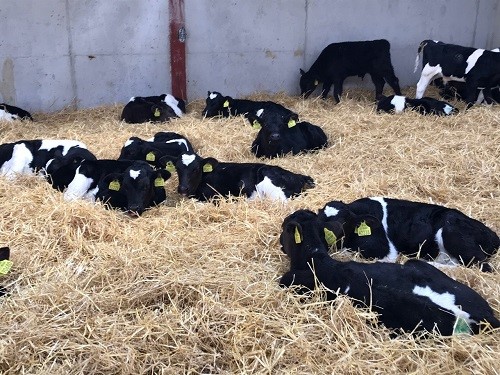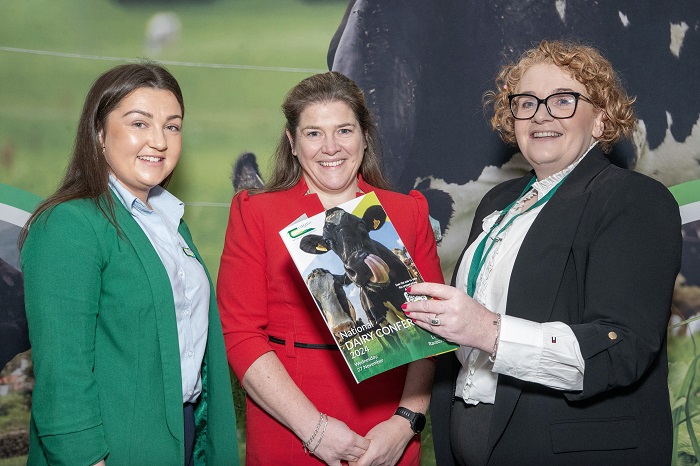20 January 2025
A refresher on colostrum management

As the busy spring calving season fast approaches, dairy farmers are reminded to prioritise colostrum management – an essential practice to ensure calf health is protected in early life.
Through the ‘managing young calves for better health outcomes’ workshop at the Teagasc National Dairy Conference, Dr. Emer Kennedy, a Senior Research Officer in Teagasc Moorepark, discussed the importance of colostrum, noting that the calf is almost entirely dependent on the absorption of maternal immunoglobulins (antibodies) from colostrum in order to provide passive immunity in the early stages of life.
“Feeding colostrum kick starts the calf’s immunity,” Dr. Kennedy explained, “and antibodies from colostrum protect calves until their own immune systems are fully functional.”
Successful colostrum management allows for adequate passive transfer to be achieved. However, where this does not occur, a number of negative consequences can occur, including: an increased risk of death and disease; slower growth rates; a reduction in long term productivity, decreased milk production in later life; increased culling rate during first lactation; and delayed time to first insemination.
As a means to ensure passive transfer is maximised, Dr. Kennedy detailed the Colostrum 1, 2, 3 rule – calves are fed the first milking only; fed within the first two hours of life to maximise antibody absorption; and fed three litres of colostrum.
Furthering this, Dr. Kennedy said: “Effective colostrum management is critical to achieve passive transfer of immunity, and the three key factors which prevent the development of passive transfer are the quality of colostrum, the timing of feeding and the volume fed. We can control the timing of feeding and the volume fed, but the one unknown is the quality of the colostrum.”

Pictured at the Teagasc National Dairy Conference are from left to right: Deirbhile Browne, Teagasc Dairy Advisor Kerry/Limerick region; Dr. Emer Kennedy, Senior Research Officer in Teagasc Moorepark; and Majella Moloney, Teagasc Kerry/Limerick Regional Manager.
Citing research undertaken at Teagasc Moorepark, Dr. Kennedy noted that the quality of colostrum produced can vary from cow to cow and herd to herd. Her key recommendation was to ensure colostrum had an IgG content of >50mg/ml before feeding to calves. Where colostrum fails to meet this threshold, it can be offered in the second or subsequent feeds, provided Johne’s is not a disease of concern on the farm.
To quantify the quality of colostrum, Dr. Kennedy recommended the use of a Brix Refractometer. Colostrum tested using this device with readings over 22% represents high-quality colostrum and is suitable for calves for their first feed.
Storing colostrum
Tips on storing quality colostrum from disease-free cows were also shared, with Dr. Kennedy recommending:
- Store quality colostrum with a Brix Refractometer reading of above 22% in a fridge within three hours of collection. This prevents bacterial growth and the denaturing of key proteins and antibodies;
- Fresh colostrum can be stored for up to 48 hours in a fridge. If not used within 48 hours, discard;
- Colostrum will last for up to one year when frozen. It can be stored in either cartons or zip-lock bags, with the latter facilitating faster defrosting due to the large surface area;
- Colostrum should never be defrosted in boiling water or in the microwave, instead leave to defrost in warm water of 37-38 degrees Celsius;
- Colostrum should always be fed warm, again use warm water to bring it to 37-38 degrees Celsius prior to feeding.
CalfCare on Farm events
Teagasc and Animal Health Ireland (AHI) are running a series of CalfCare on farm events throughout January. Supported by Feed for Growth, this series of CalfCare events is being run with the help and support of the co-ops and meat processors in each region.
Click here to view the dates and venues for these CalfCare events.
